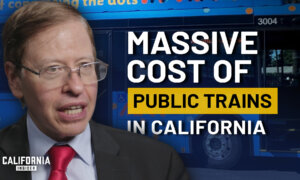California state senators grilled California Public Utilities Commission (CPUC) officeholders this week about the high price of electricity in the state.
At Wednesday’s Senate Rules hearing, senators asked CPUC Commissioner Matt Baker about the high cost of electricity for ratepayers, as Pacific Gas & Electric (PG&E) pockets massive profits.
Baker, who notes that California electricity bills are above the national average, told the Senate committee that the main drivers for the increase in the cost of electricity in the state are mainly wildfires, as well as inflation since the pandemic lockdowns. Storms have also added to the cost.
Since 2019, Baker says, nearly $30 billion, mostly in PG&E’s territory, which encompasses most of Northern California, has been added to the cost of service.
State Sen. Mike McGuire, who leads the California state Senate as the president pro tempore and represents California’s Second District from San Francisco to the Oregon border along the coast, noted during the committee hearing that there has been a 56 percent increase over the past three years in electricity costs and a 120 percent increase over the past nine years.
The senator noted that PG&E’s refusal to adapt to a changing environment, including leaving 10,000 miles of powerlines in some of the most fire-prone areas in the state, is in part to blame for the high cost of electricity.
“Where I feel incredibly frustrated is I hear PG&E say it’s because of the wildfire charge,” McGuire said. “You know why there’s a wildfire charge? Because you didn’t do your damn job for 30 years, and the climate has changed around you.
“You haven’t done a damn thing about it, but you gave some great returns to investors.”
He highlighted that the company has one of the highest-paid utility CEOs in the country while customers pay record utility bills.
“And there’s this disconnect, and I feel like the disconnect is also the Public Utilities Commission,” McGuire said.
Californians pay on average $295 per month for electricity, according to EnergySage.
PG&E made a record-breaking $2.47 billion in profits in 2024, CEO Patricia Poppe announced last week during an investor call.
During Wednesday’s Senate Energy, Utilities, and Communications Committee hearing, senators heard from CPUC President Alice Reynolds, who said the agency has been working to help reduce rates for California customers by urging utility companies to cut costs.
“We do make efforts to reduce the amount that they’re seeking as much as possible and force them to be efficient and force them to do a better job,” she told lawmakers.
Two agencies released reports on Tuesday on how consumers can save money on their monthly bills.
Gov. Gavin Newsom signed an executive order on Oct. 30, 2024, calling for CPUC and the California Energy Commission (CEC) to investigate how to save residents money.
In the reports, both agencies admitted that California utility customers are forking over more cash so the state can meet its environmental goals to achieve carbon neutrality by 2045.
In CPUC’s 38-page report, recommendations included tapping non-ratepayer funds—that is, state funds—to cover state programs.
These funds could be taken from a depleted general fund. Alternatively, utility companies could also be tapped to lower electricity costs.
CPUC highlighted the state’s Net Energy Metering program, which, according to the commission, is one of the largest contributors to surging electricity rates for those who don’t have rooftop solar.
The CPUC said using a non-ratepayer funding source could result in a 15 percent decrease in electricity costs, and also suggested subsidizing those in need with the state’s climate credits.
In a 10-page report, the CEC argued that customers’ electric and gas bills are affordable.
“While California has long had above-average electricity rates, until recent years, Californians still enjoyed some of the lowest bills in the country thanks to their low energy usage,” the report reads. “Program expenditures for CEC’s building and appliance standards programs have not substantially increased in recent years and are not responsible for the recent increase in energy bills.”
PG&E, CPUC, and CEC did reply to requests for comment by publication time.













